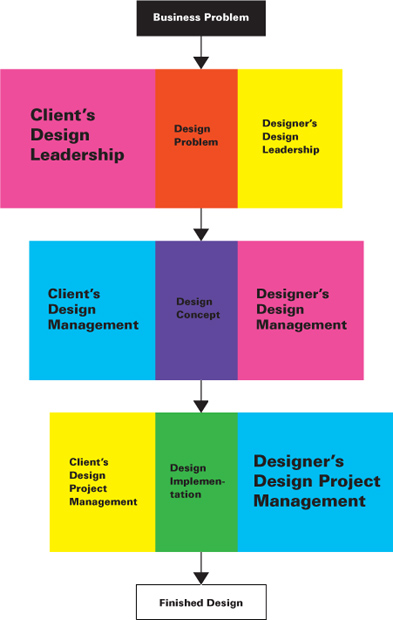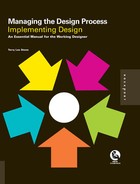Introduction
Great graphic design doesn’t happen by magic or in a vacuum. It is the result of intricately orchestrated collaboration between a designer and his or her client. It also requires well-managed collaboration within a design team composed of individuals with various skills and expertise. Although graphic design has great power to captivate, persuade, motivate, and delight, it would never get off the ground without effective planning, organization, and management. Managing the Design Process—Implementing Design is a guide to understanding and using best practices in design management that work to bring design concepts through to successful completion.
This book is about how to actualize design ideas and manage the collaborative process effectively. It may require learning some new language, tools, and techniques. In Managing the Design Process—Concept Development, the focus was on framing a design problem and developing design solutions that help to meet a client’s business goals. This challenge requires acquiring useful input and research, analyzing and processing this information, and then developing innovative design concepts that mirror and advance the client’s business strategy. In essence, this is design leadership—the process of utilizing design as a management tool to determine and achieve strategic goals.
Managing the Design Process—Implementing Design has a more tactical emphasis. It focuses on design management—coordinating and directing design resources to achieve a stated objective. Design management utilizes the people and procedures required to transform a design concept into a designed piece, be it a logo, brochure, or website. Design management activities take methodical planning and meticulous practice. Every graphic design project requires leadership and management at different stages of the design development cycle.
Digging deeper into design management, this book uncovers and explains the secrets of project management—the oversight of design jobs with specific deliverables, budgets, and schedules. Not taught in art school, good project management is the key to delivering design on time, on budget, and to the client’s satisfaction. Project management is the key to profitability, which is essential to the health and wealth of any design practice. All of this must occur while maintaining creative excellence. It’s a constant juggling act.
Design Collaboration

Managing the Design Process
—Implementing Design
The chart at left indicates the flow of designer–client collaboration from the initial business problem to the finished design that resolves, or a least supports the resolution of, that business problem. Throughout this partnership, the balance of responsibility shifts from the client to the designer as the problem is articulated (which requires design leadership), to the formation of a design concept (which requires design management), to the implementation of the design (which involves design project management). In the beginning, the client generally plays a more active role, and at the end, the burden shifts to the designer.
This chart also shows the difference in content between this book and Managing the Design Process—Concept Development. Both books feature practical, not theoretical, stories, trade secrets, and successful methodologies from real designers and their clients.
Managing the Design Process
—Concept Development
How to Use This Book
This book is a behind-the-scenes look at how designers actualize their design concepts to create finished pieces. The designers featured in this book share insights, ideas, and tactics from the real world of design management. More than discussing their aesthetic choices alone, these designers let us in on the practical aspects of their collaborations with clients and other creatives. Breaking down project management procedures, we can examine the processes required to produce great design on time and on budget in a way that makes both the client and the designer happy.
Here are some key things to take away from the case studies and project profiles in this book:
▸ How do designers structure projects for maximum efficiency and quality? Would this work for your studio?
▸ What type of agreements do designers and clients engage in? Do formal contracts work? How does your contract measure up?
▸ How do designers manage a creative brief? Can you use any of these techniques?
▸ What tools do designers use to manage their projects? Did software help? How hard is it to institute, and is it worth doing in your studio?
▸ What issues or concerns did the client have about the design? How were these addressed? What kinds of communication were required for the client to accept the designer’s recommendations?
▸ How was profitability increased? Would you be better off making a different choice?
▸ What is the finished design? What delivery medium was used? Was it effective? What do you think of it?
